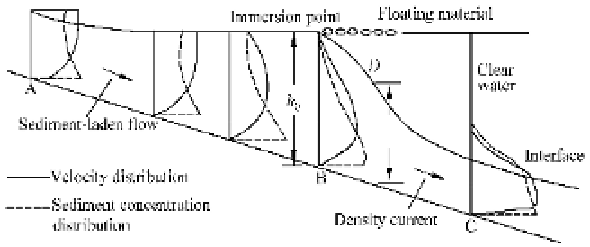Environmental Engineering Reference
In-Depth Information
slightly different densities. At the end of the 19th Century, Swiss scientists noticed that after the River
Rhone and Rhone River flowed into Lake Geneva and Lake Constance, respectively, the muddy and cold
river water did not mix with the clear and warm lake water; instead, it dove to the bottom of the lake and
continued to move as an entity. The same phenomenon was observed in Lake mead behind Hoover Dam
on the Colorado River during the flood season when muddy water formed a density current and flowed
the entire length of the reservoir. A density current may pass through the reservoir, without ever completely
mixing with the epilimnial or hypolimnial waters, and may flow out of the reservoir if the bottom outlets
are open.
Density current in reservoirs is caused by sediment, which is also called turbidity current. The turbidity
currents in reservoirs generally involve only slight differences in the sediment concentrations of the
upper and lower layers. Since the density difference is small, the reservoir water creates a large buoyancy
effect within the inflowing liquid, so that the effective gravity of the flowing liquid is greatly reduced.
Usually
g
c is defined as effective gravity given by:
gg
U
U
'
c
(7.2)
in which
g
is the gravitational acceleration, 'U is the density difference between the upper and lower
liquids, and Uis the density of the reservoir water. Many formulas describing open-channel flow apply also
to density currents once
g
is replaced by
g
c. For example, the flow pattern in an open channel depends
greatl
y
on the Froude number of the flow; in a density current, the Froude number remains the key
parameter but its form is modified as follows (Chien et al., 1998):
U
c
r
cc
(7.3)
Fr
g h
in which
U
r
is the relative velocity between the two liquid layers and
h
c is the thickness of the density
current.
Density currents usually flow near the reservoir bottom. Figure 7.20 is a schematic diagram of the
transition from an open-channel flow with a high concentration of fine sediment to a well-defined density
flow in a reservoir. After the flow enters the backwater region of the reservoir at point
A
, the velocity at
the water surface gradually tends toward zero because of the increasing depth and the backwater effect of
the dam. The reservoir water mixes with the inflow. Beyond point
B
, a distinct interface forms between
lighter water near the surface and the heavier water below. From then on, two kinds of flows with different
densities take place. Under the action of effective gravity, a density flow forms between point
B
and
C
.
During the movement, the density flow drags some of the reservoir water above the interface along with
it; other parts of the reservoir water in the upper region would then flow backwards, to maintain a water
Fig. 7.20
Velocity and sediment concentration profiles varying along the reservoir during the transition from an
open-channel flow to a density current (after Chien et al., 1998)




Search WWH ::

Custom Search